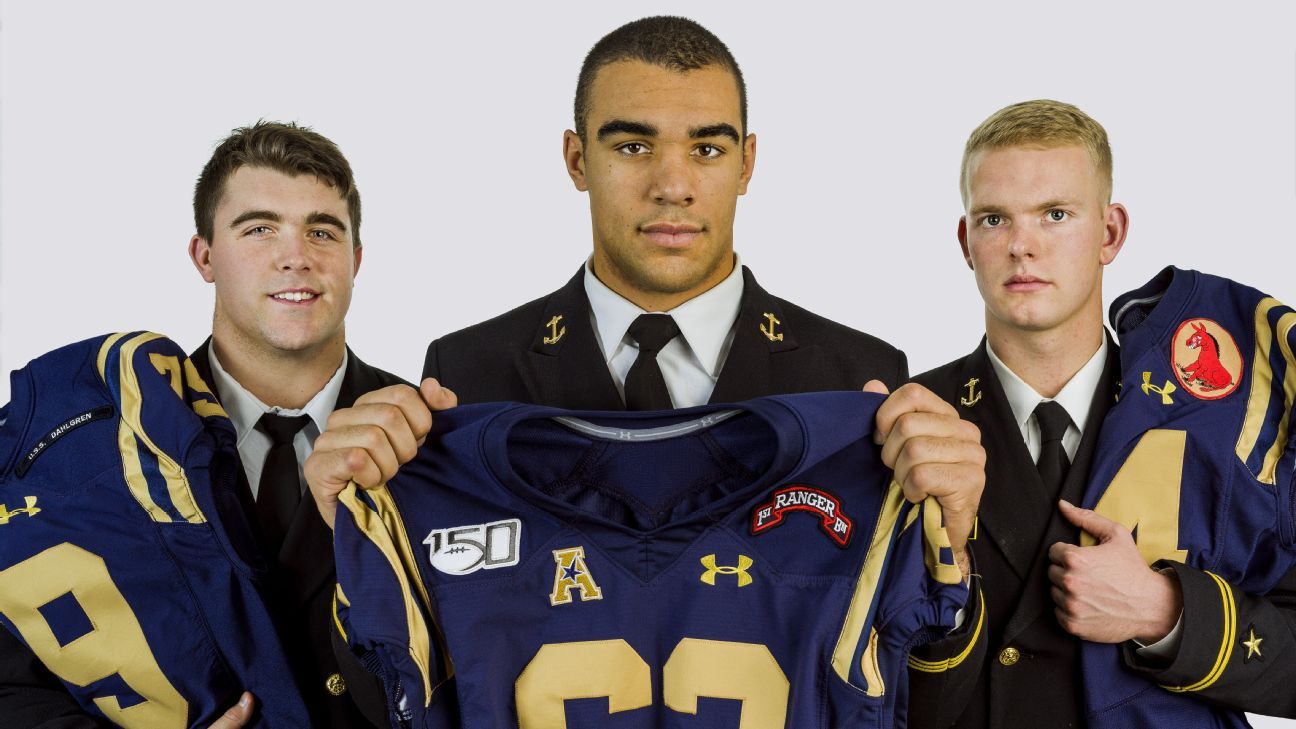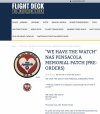Ok Academy types...why are some of the patches being worn by Navy from Army units?
Navy Football Uniform Patch List for the Army-Navy Game - Naval Academy Athletics
1 Springer VFA-41 Black Aces 2 Wiggins VMM-166 SeaElk 3 Cooper 101st Airborne Division Stepfathersnavysports.com
-
Please take a moment and update your account profile. If you have an updated account profile with basic information on why you are on Air Warriors it will help other people respond to your posts. How do you update your profile you ask?
Go here:
Edit Account Details and Profile
You are using an out of date browser. It may not display this or other websites correctly.
You should upgrade or use an alternative browser.
You should upgrade or use an alternative browser.
Active shooter at NAS Pensacola
- Thread starter Waveoff
- Start date
Ok Academy types...why are some of the patches being worn by Navy from Army units?
Not an academy guy but cool profile by ESPN on the patches. In the article, some of the Navy players say they wear patches of Army units that they have relatives in.

For Navy Midshipmen, small uniform patches carry important stories
On a campus where nearly every other decision is made for them, football players' patches are a deeply personal chance to honor a family member or veteran.
Ok Academy types...why are some of the patches being worn by Navy from Army units?
There's no restriction on the military units. Units send in patches from all over, in some cases, it's a relative or honoring a friend or someone. Once in a while, you'll get a Mid who has completed Ranger training and will wear his tab.
Spekkio
He bowls overhand.
Training and equipping watchstanders with firearms is the easy part.How does the Navy, AF, et all, develop the training plan and equipment for it?
The Marine Corps does it, but the Marine Corps is small, and has an entire training syllabus for weapons qualification for each of it's enlisted members and Officers within their initial training (E's at bootcamp and MCT/SOI and O's at TBS). Each fleet unit maintains an armory full of weapons for each T/O billet.
The hard part is that the shooting at PHNSY is one of about a half-dozen incidents in the last year (that I've heard of, which means there are more) where an American armed watchstander used his duty weapon to inflict harm upon himself or others around him. The Pensacola incident is getting more media attention because of the terrorism narrative, but the ratio of foreign terrorists vs. mentally unstable Americans shooting people on military bases is very small. The policy makers are looking at this data.
The common thread among the slew of active shooter incidents going back to Fort Hood in 2009 is they are committed by someone who is A) authorized access to the base and B) usually authorized to carry firearms, even if he doesn't use his duty weapon to commit the act.
We need a more robust screening process for issuing weapons. We have to get that part right before we expand the number of people we arm.
Last edited:
It‘s good to see this...
Navy Football Uniform Patch List for the Army-Navy Game - Naval Academy Athletics
1 Springer VFA-41 Black Aces 2 Wiggins VMM-166 SeaElk 3 Cooper 101st Airborne Division Stepfathersnavysports.com

LATE ENTRY...


Last edited:
Training and equipping watchstanders with firearms is the easy part.
The hard part is that the shooting at PHNSY is one of about a half-dozen incidents in the last year (that I've heard of, which means there are more) where an American armed watchstander used his duty weapon to inflict harm upon himself or others around him. The Pensacola incident is getting more media attention because of the terrorism narrative, but the ratio of foreign terrorists vs. mentally unstable Americans shooting people on military bases is very small. The policy makers are looking at this data.
The common thread among the slew of active shooter incidents going back to Fort Hood in 2009 is they are committed by someone who is A) authorized access to the base and B) usually authorized to carry firearms, even if he doesn't use his duty weapon to commit the act.
We need a more robust screening process for issuing weapons. We have to get that part right before we expand the number of people we arm.
More robust than the process already put in place to get a clearance? I don't necessarily disagree with you, but what do you expect to uncover that isn't already screened for as part of a C/S/TS adjudication? And those processes are already stretched to the point where the time between SSBI's has been extended and we rolled out a "continuing evaluation" program (i.e.; we can't do every 5 years so now it's 6...or 7...).
Chances are the individuals you are referencing were very well investigated at some point - it was the continual monitoring of their mental status that failed. In some cases like Fort Hood it was radicalization that (maybe?) would have been caught with electronic monitoring. In other cases the factors influencing the individuals were likely happening at home, or at least outside the view of the Navy's ability to monitor.
Ultimately these are the same individuals that we trust with weapons and weapons systems while deployed - we should be able to trust them with a sidearm back home. But the same way you wouldn't let the guy who continually pops up in an HFB to fly armed through the SOH, you probably don't want the guy always complaining about his stress at home carrying a gun on base. I know it's easy to say "we need a better way to monitor people more frequently" without a specific plan, but it seems like what's necessary.
Spekkio
He bowls overhand.
The clearance process doesn't entail a psychological evaluation. It only asks whether you have sought treatment in the past, and quite frankly if someone lies about it, no one would know.More robust than the process already put in place to get a clearance? I don't necessarily disagree with you, but what do you expect to uncover that isn't already screened for as part of a C/S/TS adjudication? And those processes are already stretched to the point where the time between SSBI's has been extended and we rolled out a "continuing evaluation" program (i.e.; we can't do every 5 years so now it's 6...or 7...).
Chances are the individuals you are referencing were very well investigated at some point - it was the continual monitoring of their mental status that failed. In some cases like Fort Hood it was radicalization that (maybe?) would have been caught with electronic monitoring. In other cases the factors influencing the individuals were likely happening at home, or at least outside the view of the Navy's ability to monitor.
Ultimately these are the same individuals that we trust with weapons and weapons systems while deployed - we should be able to trust them with a sidearm back home. But the same way you wouldn't let the guy who continually pops up in an HFB to fly armed through the SOH, you probably don't want the guy always complaining about his stress at home carrying a gun on base. I know it's easy to say "we need a better way to monitor people more frequently" without a specific plan, but it seems like what's necessary.
All of the personnel involved in the incidents over the past year in the submarine force have been cleared secret, some had a TS/SCI clearance.
Last edited:
exNavyOffRec
Well-Known Member
Training and equipping watchstanders with firearms is the easy part.
The hard part is that the shooting at PHNSY is one of about a half-dozen incidents in the last year (that I've heard of, which means there are more) where an American armed watchstander used his duty weapon to inflict harm upon himself or others around him. The Pensacola incident is getting more media attention because of the terrorism narrative, but the ratio of foreign terrorists vs. mentally unstable Americans shooting people on military bases is very small. The policy makers are looking at this data.
The common thread among the slew of active shooter incidents going back to Fort Hood in 2009 is they are committed by someone who is A) authorized access to the base and B) usually authorized to carry firearms, even if he doesn't use his duty weapon to commit the act.
We need a more robust screening process for issuing weapons. We have to get that part right before we expand the number of people we arm.
It would be interesting to see if the people involved in the incidents had rec'd a waiver for past psychological issues, of course that probably isn't something that would be released.
I do think a better screening process would be good as well as regular updates to make sure a persons life isn't collapsing around them.
There is also the leadership part, a good leader knows his people, and tries to know what is going on in their lives. I have had a few shitty leaders (CPO's to senior officers) and they can make your life hell, I have seen people break that I never thought would, it was during those shitty leaders that I saw more sailors talk about hurting themselves than any other time. In each case the persons reputation had preceded them as being bad to their people. The USN is quick to discard a good officer who damages a ship, but a shitty officer who destroys lives, it can take years for them to get shit canned, if at all.
I am also not about coddling sailors, if they mess up they get punished, set the standard, make sure they have what they need to get there and hold them accountable.
Navy Posthumously Advances NAS Pensacola Shooting Victims
<p>The Navy posthumously advanced Airman Mohammed S. Haitham and Airman Apprentice Cameron S. Walters to Naval Aircrewma
How does the Navy, AF, et all, develop the training plan and equipment for it?
The Marine Corps does it, but the Marine Corps is small, and has an entire training syllabus for weapons qualification for each of it's enlisted members and Officers within their initial training (E's at bootcamp and MCT/SOI and O's at TBS). Each fleet unit maintains an armory full of weapons for each T/O billet.
I understand why, as policy, we don't accept an out in town concealed carry on base. The military doesn't rely on out in town training for... well... pretty much anything...
So if we can fit in shooting and range time at basic training, and we can afford a week or more each year of requalification training I'm all for it.
Granting a basic firearms qual isn't the barrier to arm people on the Navy side.
Unless things have changed greatly in the last few years, recruits are supposed to get the M9 Handgun qual out of Great Lakes. We had a few show up without for reasons, but it was at least part of the curriculum. Pretty sure USNA does as well.
But the M9/M11 NHQC isn't anything other than punching holes in paper at fixed ranges and plenty of time.
Actual armed watchstanders have to go through more of a "Force Protection" type of training curriculum in order to stand those watches with a firearm. Which also includes some bare bones, but still better firearms training (Practical Weapons Course and Low Light).
Finding the happy medium solution between everybody with a CCW carrying personal firearms and only designated armed watchstanders is something that is going to be very difficult to solve with a Navy wide policy, unless that policy simply grants broad latitude to individual commanders or base CO's to administer. Especially all the questions ranging from trivial (uniform policies) to significant (integration into FP exercises).
Do Navy units even have officer watch standers? I seem to remember laughing at Navy dudes and dudettes bitching about being “on duty” for their squadron, which apparently consisted of taking a cell phone home. Every Marine unit I’ve been in has a 24 hour duty that is an officer and/or SNCO that’s armed.Granting a basic firearms qual isn't the barrier to arm people on the Navy side.
Unless things have changed greatly in the last few years, recruits are supposed to get the M9 Handgun qual out of Great Lakes. We had a few show up without for reasons, but it was at least part of the curriculum. Pretty sure USNA does as well.
But the M9/M11 NHQC isn't anything other than punching holes in paper at fixed ranges and plenty of time.
Actual armed watchstanders have to go through more of a "Force Protection" type of training curriculum in order to stand those watches with a firearm. Which also includes some bare bones, but still better firearms training (Practical Weapons Course and Low Light).
Finding the happy medium solution between everybody with a CCW carrying personal firearms and only designated armed watchstanders is something that is going to be very difficult to solve with a Navy wide policy, unless that policy simply grants broad latitude to individual commanders or base CO's to administer. Especially all the questions ranging from trivial (uniform policies) to significant (integration into FP exercises).
Leaving it up to local commanders will have the obvious outcome of risk averse pussies doing the math on what is more likely to get them fired.
I'm not sure about other communities, but in most VP squadrons, JOs man a squadron duty office. This is usually a 24 hr watch requiring said officer to be in the squadron workplace during business hours as well as during any period of flight ops. Uniform is usually khakis. When the duty officer is authorised to retire to recall, they must be immediately reachable and an enlisted watch still mans the office, since they usually have a shorter rotation (e.g., 8 hrs). Nobody is armed.Do Navy units even have officer watch standers? I seem to remember laughing at Navy dudes and dudettes bitching about being “on duty” for their squadron, which apparently consisted of taking a cell phone home. Every Marine unit I’ve been in has a 24 hour duty that is an officer and/or SNCO that’s armed.
Leaving it up to local commanders will have the obvious outcome of risk averse pussies doing the math on what is more likely to get them fired.
Finding the happy medium solution between everybody with a CCW carrying personal firearms and only designated armed watchstanders is something that is going to be very difficult to solve with a Navy wide policy, unless that policy simply grants broad latitude to individual commanders or base CO's to administer. Especially all the questions ranging from trivial (uniform policies) to significant (integration into FP exercises).
Commandant of the Marine Corps says," Every Marine watch stander will be condition 1." And immediately everyone says," Yes, that makes sense, because Marines and guns go together like... well, Marines and guns."
But I don't see the same thing if the CNO says it about the Navy.
Culturally the Navy isn't a gun club- It's a boat and airplane club.
And I still think honoring out in town CCW on base is stupid. Train to the standard you need. If we need it on base, then develop a program, spend the money and train to it. And why CCW? If you're trained to use that weapon, check it out from the armory at the beginning of the day and open carry it. Open carry is a bigger threat deterrent.
I’m pro gun, and I carry, but I don’t see how concealed carry would work. I can’t really imagine how I would conceal carry in uniform, especially in a squadron.Commandant of the Marine Corps says," Every Marine watch stander will be condition 1." And immediately everyone says," Yes, that makes sense, because Marines and guns go together like... well, Marines and guns."
But I don't see the same thing if the CNO says it about the Navy.
Culturally the Navy isn't a gun club- It's a boat and airplane club.
And I still think honoring out in town CCW on base is stupid. Train to the standard you need. If we need it on base, then develop a program, spend the money and train to it. And why CCW? If you're trained to use that weapon, check it out from the armory at the beginning of the day and open carry it. Open carry is a bigger threat deterrent.
Change the culture, have armed officers and senior enlisted watch standers. The PFC/LCPL next to me on duty in a Marine squadron wasn’t armed. Partially because they aren’t pistol qualified and partially because it’s not worth the risk. Time is a good way to weed out crazy.
Is this a real question or were you never really around an active Navy squadron during your time in?Do Navy units even have officer watch standers?
